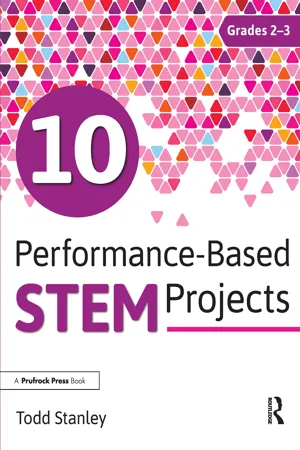
- 156 pages
- English
- ePUB (mobile friendly)
- Available on iOS & Android
10 Performance-Based STEM Projects for Grades 2-3
About This Book
10 Performance-Based STEM Projects for Grades 2-3 provides 10 ready-made projects designed to help students achieve higher levels of thinking and develop 21st-century skills while learning about science, technology, engineering, and math. Projects are aligned to national standards and feature crosscurricular connections, allowing students to explore and be creative as well as gain an enduring understanding. Each project is linked to national STEM education goals and represents one of a variety of performance assessments, including oral presentations, research papers, and exhibitions. Included for each project are a suggested calendar to allow teachers to easily plan a schedule, mini-lessons that allow students to build capacity and gain an understanding of what they are doing, as well as multiple rubrics that can be used to objectively assess the performance of students. The lessons are laid out in an easy-to-follow format that will allow teachers to implement the projects immediately.
Grades 2-3
Frequently asked questions
Information
1
Communicate Effectively
- ► The presentation can be clearly heard the entire time, and the participant speaks slowly and clearly throughout.
- ► The presenter's demeanor is professional throughout. It sounds as though the presentation has been rehearsed several times.
- ► The presentation is organized in a manner that makes it easy to follow and to understand what is going on at any given time.
- ► The brochure has little to no spelling/grammatical errors.
- ► The brochure is typed in a format that makes it easy to view.
- ► The brochure uses sentence structures that make the paragraphs flow and easy to read.
- ► The project is organized clearly, allowing someone to know what is being discussed at any given time.
- ► The student provides plenty of examples to back up statements made.
- ► The student provides much detail, explaining concepts and ideas so that someone can gain a full understanding of what is being talked about.

Create a Book Trailer
Materials
- ► Student computer and Internet access
- ► Project Outline: Create a Book Trailer (student copies)
- ► Suggested Timeline
- ► Lesson: What Goes on the Back of a Book Cover?
- ► Lesson: How to Shorten a 2-Hour Movie Into a 2-Minute Trailer
- ► Handout 1.1: Writing a Book Description (student copies)
- ► Handout 1.2: Storyboarding Your Book Trailer (student copies)
- ► Handout 1.3: Sharing With a Focus Group (student copies)
- ► Product Rubric: Create a Book Trailer (student copies)
PROJECT OUTLINE Create a Book Trailer
Big Idea
Essential Question
Deliverables
Constraints
- ► be created using a video-editing application, such as iMovie, One True Media, or Video Toolbox; and
- ► be 1-3 minutes long.
Suggested Timeline
| DAY | ||||
| 1 Introduce the project and conduct Lesson: What Goes on the Back of a Book Cover? Ask. | 2 Conduct Lesson: How to Shorten a 2-Hour Movie Into a 2-Minute Trailer. Ask. | 3 Have students choose their books and complete Handout 1.1. Imagine. | 4 Have students plan their trailers and complete Handout 1.2. Plan. | 5 Have students continue to plan their trailers. Plan. |
| 6 Have students begin creating their book trailers. Create. | 7 Have students continue creating their book trailers. Create. | 8 Have students finish their book trailers. Create. | 9 Have students screen their trailers to a focus group (see Handout 1.3). Improve. | 10 Have students present their trailers to the class. |
LESSON What Goes on the Back of a Book Cover?
- Ask students: Have you ever bought a hook based on the description on the back? Tell students that when publishers publish books, they have to try to persuade people to buy a book based on the description of what the book is about. These summaries are not usually very long.
- Share with students some examples of book descriptions, such as the descripti...
Table of contents
- Cover
- Half Title
- Title Page
- Copyright Page
- Table of Contents
- INTRODUCTION
- Project 1: Communicate Effectively
- Project 2: Focus on Inquiry and Collaboration
- Project 3: Understand Multiple Content Areas
- Project 4: Explore Contemporary Issues
- Project 5: Use Technology, Math, and Reasoning
- Project 6: Use and Analyze Models
- Project 7: Record and Analyze Data
- Project 8: Investigate Change Over Time and Patterns
- Project 9: Use Computer Models or Simulations
- Project 10: Construct and Explain Systems
- DEVELOP YOUR OWN STEM PROJECTS
- REFERENCES
- ABOUT THE AUTHOR
- NEXT GENERATION SCIENCE STANDARDS ALIGNMENT
- COMMON CORE STATE STANDARDS ALIGNMENT